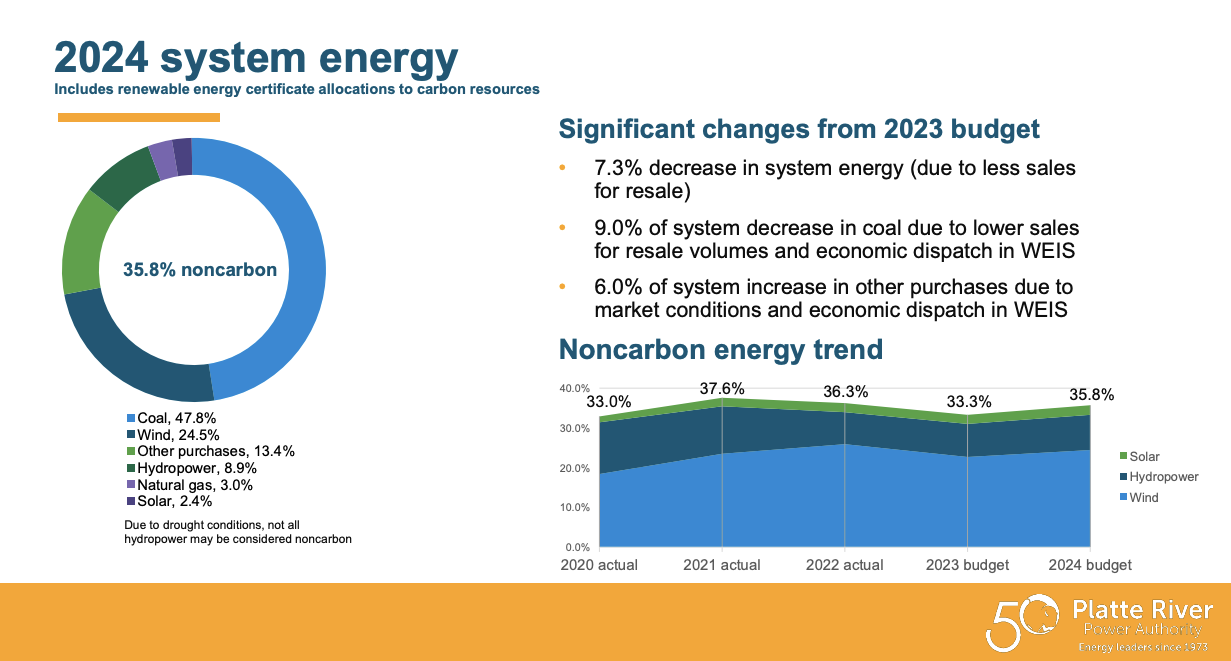PRPA board to hear recommendations for non-carbon power generation

FORT COLLINS — Much of the discussion at the member cities of Platte River Power Authority has centered on using solar- and wind-generated power solutions to help the utility reach aggressive non-carbon power generating goals by 2030.
As of today, the wholesale utility serving Fort Collins, Loveland, Longmont and Estes Park generates 33% of its power from non-carbon sources, mostly wind (22.7%). Yet by themselves, those solar, wind and diminishing hydropower sources won’t enable the utility to reach its goal of 100% non-carbon by 2030 while maintaining the primary pillars of the organization’s mission: reliability, environmental responsibility and financial sustainability, according to PRPA staff members who briefed members of the media Wednesday ahead of Thursday’s board meeting.
At the Thursday meeting, the board will be asked to weigh in on recommended strategies to continue working toward the 2030 goal. Those recommendations will include new sources of what the utility calls “dispatchable capacity” — namely generators to replace the coal-fired Rawhide 1 power plant north of Fort Collins that can be called into service on demand to meet loads that solar and wind can’t handle.
SPONSORED CONTENT
Select your Republic Services residential cart now!
In preparation for Republic Services becoming the primary provider of residential recycling, yard trimmings, and trash, residents should now select the best cart size and service schedule for their household needs.
Raj Setti, sustainability and transition officer for the utility, said that technology has not evolved enough to become totally non-carbon in operation, but it’s coming. In the meantime, PRPA has to plan for days when the sun doesn’t shine or the wind doesn’t blow, along with weather events that cause spikes in usage or disruption in operations. Drought conditions that reduce power generation on the Colorado River also are factors that the utility has to consider, he said.
One of the recommendations to the board will be installation of new aeroderivative turbines — generators devised from jet engine technology — that would be placed at the Rawhide campus. The turbines would be designed to produce at least 200 megawatts of dispatchable capacity and use the lowest emitting fuels possible, including hydrogen and renewable natural gas. Initially, they would run on natural gas until the ability to produce hydrogen and store it becomes commercially available.
Hydrogen technology will be available by 2030, but whether the hydrogen itself will be available for storage is another question, he said.
Setti referred to “dark calms,” when neither the wind nor sun is available. He cited instances of that in recent history — a week in February 2021, for example — that would have disrupted power if those sources were the only strategies in use.
“We look at the gaps as a problem to be solved but not by one technology,” he said.
Among the solutions will be “virtual power plants” in which customer information is gathered and efforts put into place to change customer behavior; energy storage, both short and long duration; and new dispatchable capacity.
The utility is already experimenting with a short-duration Tesla battery capable of storing and then releasing power over four hours. What’s needed is a long-duration battery that could release power over 100 hours. Xcel Energy just received a federal grant to experiment with long-duration battery installations in Minnesota and Colorado.
PRPA also, as previously announced, is engaging in a power-sharing network through the Southwest Power Pool that will result by 2025 in an organized market to buy and sell excess electricity.
Meanwhile, while scientists and engineers work on future power sources for PRPA, the utility also is working on how it will deploy its 300-member workforce, about 100 of whom work at Rawhide.
Eddie Gutierrez, chief strategy officer, said the utility is intent upon transitioning the existing power plant workers as the coal generator is retired in 2029.
The PRPA board meeting will begin at 9 a.m. at utility headquarters in Fort Collins. Online viewing is available.
FORT COLLINS — Much of the discussion at the member cities of Platte River Power Authority has centered on using solar- and wind-generated power solutions to help the utility reach aggressive non-carbon power generating goals by 2030.
As of today, the wholesale utility serving Fort Collins, Loveland, Longmont and Estes Park generates 33% of its power from non-carbon sources, mostly wind (22.7%). Yet by themselves, those solar, wind and diminishing hydropower sources won’t enable the utility to reach its goal of 100% non-carbon by 2030 while maintaining the primary pillars of the organization’s mission: reliability, environmental responsibility and financial sustainability, according…
THIS ARTICLE IS FOR SUBSCRIBERS ONLY
Continue reading for less than $3 per week!
Get a month of award-winning local business news, trends and insights
Access award-winning content today!


